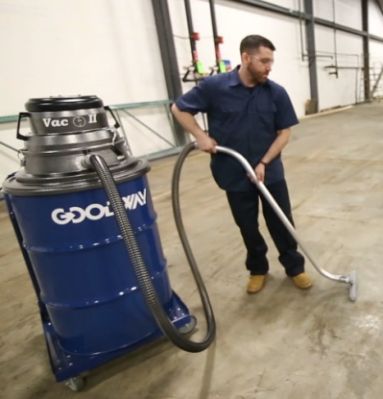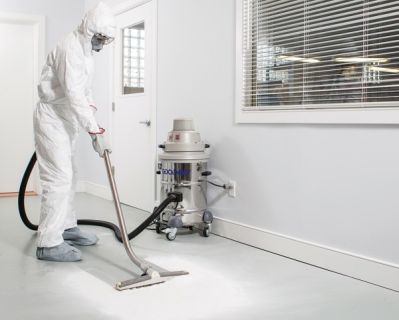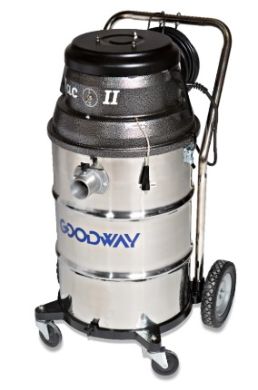5 Steps for Selecting the Right Industrial Vacuum for Your Shop (Watch Video)
Finding an industrial vacuum cleaner that matches the environment and application will result in more effective and safe cleaning.

Industrial vacuum cleaners can be a critical element to keeping a facility clean. Choosing the wrong vacuum can be costly and dangerous. Goodway Technologies is offering tips on how to select the best solution for the job. Many industrial vacuum cleaners are available and picking the most appropriate option can be overwhelming for maintenance personnel.
Step One: Determine the Application
Industrial vacuums deliver the best performance when the features and specifications align with the intended application. Using the wrong vacuum will lead to poor performance and vacuum burnouts -- a costly mistake. It's essential to understand what kind of materials will be collected -- from the smallest grain of powder to the largest piece of scraps.
From the size of the particles to whether or not they are flammable or combustible, understanding the environment and the material will assist in making an informed buying decision. Examples of the common substances industrial vacuum cleaners are designed to handle safely include scrap metal, metal chips, coolant, dust, debris, paint powder, and floodwater.
The application's consistency alone can help determine whether a wet vacuum, a dry vacuum, or a combined wet/dry vacuum is required. Dry vacuums are designed to pick up lighter particles, while wet vacuums use heavy-duty pumps to move dense, heavier liquids.
VIDEO: Goodway VAC-2 Industrial Wet/Dry Vacuum with Twin Motors
It's recommended to purchase a vacuum that meets the primary application -- whether it be for dry or wet applications. However, if there is a need to pick up both wet and dry substances, wet/dry vacuums can perform in both cases.
Step Two: Identify the Appropriate Filtration System
One of the most frequently asked questions when purchasing an industrial vacuum cleaner for dry pickup is which filter is the best. The environment and the application strongly influence whether to use a HEPA or a Standard filter.
HEPA Filters
According to the Occupational Safety and Health Administration, a HEPA, or high-efficiency particular air filter, is defined as a filter that is at least 99.97% efficient in removing particles of 0.3 micrometers in diameter. To provide context, that's much smaller than a coffee ground or even one single grain of cayenne pepper.

HEPA filters were created to capture microscopic substances, like dust mites and other airborne particles that can be hazardous or cause health issues. Depending on the industry, there are strict maintenance guidelines that must be adhered to clean a facility properly.
Standard Filters
Standard filtration generally filters to around 10 microns and performs well for filtration of larger material pickup or areas where fine or hazardous materials aren't being picked up. Standard filters would not be sufficient for higher-risk areas. While standard filters can certainly be effective, they don't offer the same amount of filtration as HEPA filters. This is where understanding the environment can help determine which is the best solution.
Step Three: Find Out How Much Power You Need
Some might assume that the motor's horsepower rating automatically determines its ability to pick up materials. However, the horsepower of an industrial vacuum isn't the primary factor that should be assessed.
Airflow Speed -- If the application requires the pickup of dry materials, the airflow is a vital detail to consider. The airflow speed is measured by cubic feet per minute (CFM), and this force draws and collects particles inside the vacuum. The higher the CFM of the airflow, the more volume received when picking up fine powders, such as flour or dust particles.
Static Lift -- The static lift is directly related to the power of the airflow and its ability to lift the material. Vacuums designed for lifting liquids or heavy metals will have high lift specifications. When suctioning fluids with heavy density, such as water, it requires a higher static lift and a lower CFM to allow the vacuum to lift these substances.
Step Four: Understand the Necessary Capacity
Industrial vacuums don't utilize small collection or dust bags that need to be frequently replaced. They are designed with larger capacity to simplify the process and typically come in various sizes to meet different needs.

In addition to the size, the canisters where the debris or liquid is collected may also come with different features. For wet vacuums, consider an option with a tilting tank or pump to make it easier to remove the accumulated liquid.
Step Five: Does it Require Special Features
Industrial vacuum cleaners have specific needs depending on what you're vacuuming. The machine has to handle different substances that may cause problems if not appropriately handled -- such as flammable or combustible substances.
A good practice for choosing your industrial vacuum cleaner is assessing what materials and voltage you will use to maintain safety protocols. When cleaning areas where hazardous dust or liquid is present, vacuums should be explicitly certified for those material pickups. Using products that are not certified could result in catastrophic explosive results.
Want more information? Click below.
Rate this article
View our terms of use and privacy policy